Tiananmen Square 25 Years Later
After two and a half decades, the images of June 4, 1989 resonate with many, unless you happen to live in China.

Twenty-five years ago today, the Chinese People’s Liberation Army moved into Tiananmen Square and brought a swift, sudden, and brutal end to protests that had filled the most important area in Beijing for several weeks. Coming as they did in the same year as political change was sweeping Eastern Europe and the Soviet Union, it was really quite an extraordinary thing to watch, all the more so because the Chinese government amazingly did not take many steps to prevent worldwide media from reporting on the protests and the subsequent crackdown. For a time, with banners, the enthusiasm of the students and those who joined them in the square, and the “Goddess of Democracy” that bore a remarkable resemblance to the Statue of Liberty, there was some thought that the protests would lead to real change in China. Nobody realistically expected the downfall of the Communist Party, but then the students weren’t really demanding that. Instead, their protests were at least initially inspired by the death of Hu Yaobang, who was generally seen as a reformer and had previously been stripped of power by party hardliners. The students wanted reforms in the party and a greater voice for the people, basically. The leadership, of course, would have none of it, and brought in troops from outside Beijing to crush the protesters.
Of all the images of the Tiananmen Square protests and massacre, there are few that are quite as memorable as those of the grainy videos and photos of a single man in a white shirt and dark pants standing in front of a column of Chinese tanks the morning after the massacre. We still don’t know who that man was or what happened to him, but his memory lives on:
It’s an iconic image that defined courage and defiance for a generation around the globe.
But little is known about the man who blocked the path of a column tanks in Tiananmen Square in Beijing 25 years ago, on June 5, 1989.
Over the years he has come to be known as the “Tank Man,” the “Unknown Rebel,” or the “Unknown Protester.”
Some reports have identified the man as Wang Weilin, but his true identity has not been confirmed. The South Korean news agency Yonhap reported in 2006 that Wang Weilin was an alias and that he had escaped the massacre in Tiananmen Square and has made his way to Taiwan via Hong Kong.
What we do know about him are his actions, captured that day in stunning video footage.
The video shows the man blocking more than a dozen tanks that were rolling down Chang’an Avenue the day after hundreds of student protesters were gunned down by the Chinese military. The lead tank moves back and forth, trying to go around the man, but the man kept of blocking its path. The man then climbs up on the lead tank and appears to talk to one of the soldiers inside the tank.
The man is eventually led away by his arms by two men. It remains unclear if those men were police or security forces, or just bystanders who were concerned about the man.
There was something about that image that resonated across the world. Perhaps it was the just the image of a single man standing down a column of tanks. Perhaps it was the fact that it happened in the beginning of a year that brought freedom to parts of the world that had lived in darkness for so long. Whatever it was, the image is one that has resonated through the years, at least outside China. Just over two years after the massacre, I wrote my own small reflection on the meaning of that image. And, over at The Washington Post Radley Balko puts it this way and suggests that the rest of the world draw some inspiration from the events of June 4th:
In some ways, the Tiananmen protests failed. The crackdown ended the democracy movement. The protest leaders who weren’t murdered were arrested and imprisoned. The reforms introduced in China over the previous decade were rescinded, and a more oppressive, autocratic regime took over. But the Tiananmen protests also mark the brink of a more significant and profound revolution — the technological revolution that has made governments more accountable and transparent than any period in human history.
(…)
The beautiful thing about all of this is that today, anyone can be Tank Man, at least metaphorically. Carlos Miller is a good example. Years ago, Miller was arrested for photographing a police officer. He wrote about that arrest on a blog. After hearing about similar arrests, he started the blog Photography Is Not a Crime. Today, he relentlessly documents cases in which police have violated a citizen’s First Amendment right to record on-duty law enforcement officials. He has also unquestionably been a big reason why that right is now recognized in every state in the country. Miller’s first book comes out this week — a how-to guide to citizen journalism. Antonio Buehler had a similar experience. In 2010, Buehler was arrested for using his cell phone to record what he thought was a police abuse incident at a gas station. The experience moved Buehler — a West Point graduate and Stanford business school graduate currently attending Harvard — to start the Peaceful Streets Project, a police watchdog organization.
But you needn’t be a journalist or even have had some traumatic experience with law enforcement to be your own Tank Man. Anyone can file an open records request. You don’t need to be affiliated with any media outlet. The Student Press Law Center has an easy-to-use generator on its website. Just plug in your state and what you’re looking for and it will produce a request for you to print out and mail.
I suggest we start looking at June 4 as an opportunity to remember and reflect upon those atrocities. It should be a day when we celebrate whistleblowers and martyrs, recognize journalists and activists who were ignored or pilloried for exposing injustice, and remember the 174 million people murdered by governments in the 20th century alone.
I’m not suggesting anything formal, here. Some sort of state-recognized holiday would completely miss the point. Rather, I’m suggesting a voluntary day of remembrance, and perhaps a day in which we each do something, even a small thing, to keep a local, state, or federal government a little more transparent, a little more accountable. Submit an open records request. Donate to an organization that fights government abuse. This isn’t a partisan thing. There are worthy groups on the right, left, and elsewhere. Write a letter to the editor. Plan to attend a protest.
This isn’t about full-time activism, anarchism, or abolishing the government. Nor am I suggesting that bad interactions with police or a local zoning board is the equivalent of the Tiananmen massacre. My point that governments have enormous power, including a monopoly on the legitimate use of force. Because governments are made up of flawed human beings, there will always be potential for that power to abuse and oppress. So it’s important that we be vigilant about keeping governments answerable to the people they serve.
However, while the rest of the world remembers what happened in Beijing on that June day, if you go to China itself on this day twenty five years later, it’s hard to find any signs that the protests or the massacre ever even happened:
BEIJING — It was a quiet day in Tiananmen Square. Even as tens of thousands gathered in Hong Kong and global headlines marked the 25th anniversary of China’s brutal crackdown on student protesters, there was no trace of remembrance at the site of their killing.
Tourists posed for pictures below the iconic portrait of Mao Zedong. Children ran laughing through the square.
The only sign of that day’s lingering effects: swarms of police patrolling the square and stationed every few hundred feet on the roads leading up to it.
For weeks, as the anniversary approached, security in Beijing grew tighter. Foreign journalists were called in and warned. Officials mobilized tens of thousands of informants to look for suspicious activity, according to state media. Authorities jailed or forced out of the city dissidents most likely to criticize the Communist government. By Wednesday, the heart of the capital was in lockdown.
The repressive tactics this year began earlier and were more extensive, a sign that the party views the historical event as an enduring threat.
In hushed interviews at the square Wednesday, some demonstrated just how effectively the party has quashed public memory of a crackdown that killed hundreds, if not thousands. Many claimed to have no remembrance of the massacre or were too afraid to respond.
“Today? What is special about today?” a tourist, 41, from Hunan province answered in response to a query. When pressed whether he had not heard about an incident in 1989, he said nervously, “Oh, you mean the student protest back then? That was today? I had forgotten all about it.”
He then quickly walked away.
Three local college students — among the few willing to acknowledge and talk openly about the massacre — said they had come to the square out of curiosity. Several police officers hovered nearby.
“Of course we know about June 4th. It’s an open secret in China,” said one of the students, standing in the same spot that 25 years earlier had been packed by a sea of protesters his age demanding political change.
But just because they knew about the 1989 massacre didn’t necessarily mean they agreed with the protesters.
“It was an irrational decision. Was it worth it to bleed and be killed for such a cause?” the student said.
Many former protesters, who witnessed those deaths, blame such reactions on the government’s propaganda, with classes and textbooks casting the 1989 protest as counter-revolutionary riot that threatened the country.
“This is why we, the survivors, must try our best to tell the next generation about our experience and help them achieve progress without sacrificing as much as we did,” said Xiang Xiaoji, 57, a former protester who now lives in New York.
Things were a bit different in Hong Kong which, while part of China, has retained much of its independent spirit in the decade and a half since it became part of China:
HONG KONG — Tens of thousands gathered at a central park in Hong Kong on Wednesday to commemorate the 25th anniversary of the Tiananmen Square crackdown, even as a stifling security presence in Beijing and elsewhere in mainland China appeared to forestall protests.
The organizers of the vigil in Hong Kong said the crowd on Wednesday numbered over 180,000, while the police estimated that 99,500 people had attended. The turnout on Wednesday was the largest since 1989, according to the organizers, and the second-largest according to police estimates, trailing the 2010 turnout, which was 113,000.
State-controlled Chinese news organizations largely ignored the anniversary, even as the foreign news media gave it global attention. In Washington, the White House said in a statement, “Twenty-five years later, the United States continues to honor the memories of those who gave their lives in and around Tiananmen Square and throughout China, and we call on Chinese authorities to account for those killed, detained, or missing in connection with the events surrounding June 4, 1989.”
In the years since the crackdown, mainland China has combined rapid economic growth with severe and recently increasing restrictions on civil liberties. In the weeks preceding the anniversary, the Chinese police detained and in some cases prosecuted scores of human rights activists.
Online censors have stepped up their already extensive blocking or deleting of websites and postings that challenge the Communist Party’s effort to erase the public’s memory of the bloodshed in 1989, when soldiers in Beijing killed hundreds of students, workers and professionals demonstrating for greater democracy and limits on corruption.
The crowd that gathered Wednesday night in Victoria Park in Hong Kong was visibly younger than in previous years and included, for the first time, Cardinal Joseph Zen, a widely admired Roman Catholic priest who in the past had held prayers near the commemoration but not taken part.
In recent years, the gathering had been dominated by people age 40 or older who remembered coverage of the night of the crackdown and who sometimes brought their children. That demographic profile appeared to have been upended this year, as people in their 20s and 30s predominated. An announcer on the stage asked all those attending the vigil for the first time to raise their hands, and many sprung up.
As China becomes more educated, and its people more exposed to the rest of the world, there’s still hope that things will change. Every June 4th, I use the occasion to tell myself to hope.
One first-time attendee, Rex Liu, a 27-year-old office worker, said that although he felt regret that students had died 25 years ago, he was motivated more by concern about the prevalence of corruption in current-day China. “I feel the need to come this year to express my discontent over the rotting and corrupt state of the Chinese government,” he said.
The general silence about the anniversary that security agencies imposed in mainland China left Hong Kong as the only city on Chinese soil where such a public commemoration could take place.many of
Twenty-five years after Tiananmen, China is of course a very different place than it used to be. It is far more prosperous and, at least in the cities, many of the citizens have been able to take part in that prosperity to a greater extent than was possible before. While the nation remains officially Communist, international trade and the expansion of capitalism have allowed for the existence of a free market economy to at least some degree, although the real levers of economic control remain firmly in the hands of the state. The state of civil liberties doesn’t seem to be much better, however. Political opposition is essentially forbidden, and Western newscasts are routinely censored by the government. For example, both CNN and CNBC have reported this week that reports which they aired on their international channels about the anniversary of the massacre were blacked out for Chinese viewers. Additionally, as we’ve seen in recent years, China has blocked access to various sites on the Internet for its citizens based on content that it apparently believed to be a threat to the regime. There may be prosperity, of a sort, in China today, but there is not freedom, and the sad thing about it that it’s not even clear that the Chinese people care.
Hopefully that won’t be the case for long and that someday, they’ll be able to mark the day that people were mowed down by the state for having the temerity to ask for political reform the way it deserves to be remembered. When that happens, that’s when we’ll know that China is actually free.

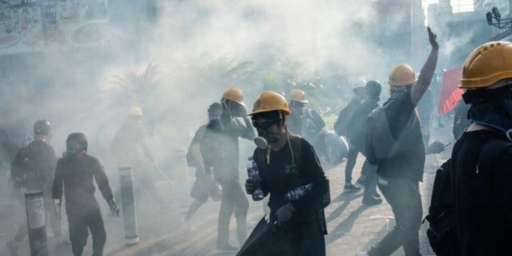
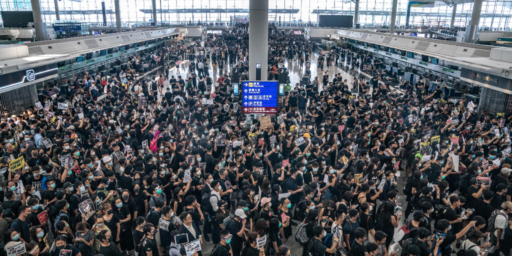
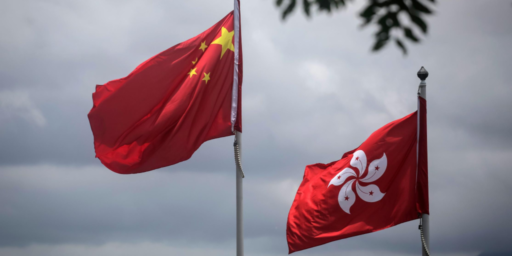
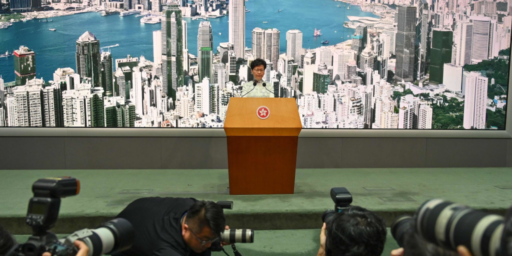
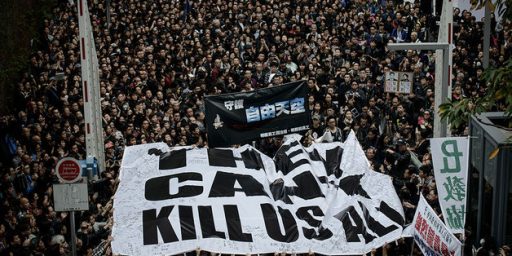
Do we?
If only Tank Man had a gun. He could have watered the tree of liberty by firing on the tank. Then he could have been blown away, probably leading to a far greater slaughter and in the process lose the sympathy of the world.
Instead, like Gandhi, like Martin Luther King, he just refused to be intimidated and stood up (literally) for what was right.
But still, totally should have had a gun. Gun = Freedom. Unless of course the other guy’s gun is a Type 59 tank. Then gun = not so much freedom. So the solution is obvious: if we want to remain free, we need all Americans to own a tank. And drive them to Chili’s.
Well, I prefer “Cookout” (you can eat outside on top of your tank), or one of our local fish camps. A US Army tank in the parking lot would really pack them in !
Was in Beijing Aug. 89, a real pit, a stiflingly anal city full of army/security officials wearing Mao jackets and shop owners intent on ripping off the tourist – a shit hole really. No one would go there but for the cultural and historic monuments and sights. A complete opposite of Shanghai, a port town with a heavy European influence and far enough away from the dominance of the ham handed authorities in Beijing to at least feel cosmopolitian and a bit free.
Anyway, I had a photocopy (a Xerox copy for those of you old enough to remember) of the Declaration of independence and the Preamble and made my way to the exact spot where Tank Man had stood, and dodging 3 AM traffic proceeded to tape both onto the street. Ok, it was in English and it was late at night so I wasn’t exactly Mohamed Bouazizi, but it was enough to say FU to the tyrants who still control China.
Flash forward just a few months later and I am watching the first stirrings in Berlin of another student lead protest. This after the blatherings earlier in the decade by Reaganut Jean Kirkpatrick that communism would never fall since reform and elections were impossible in “socialist” societies. I call Lufthansa and for a then staggering price of $1600 booked the first flight to Berlin and proceeded to dance on top of the Wall in what was still the greatest party since VJ day. (I am old).
From June 89 to Feb 90, you had the Tiananmen revolt, the Wall fall and Mandela released from detention. A worldwind of freedom and proof of the power of the individual to affect change
and progress. A lesson lost on a new generation of open carry gun freaks and wealth worshippers.
Wait a minute. Hold up…Doug wrote for The Freeman? In 1991? How old was he then? 35? (I admit, I was only a couple of months old when Tiannenmen happened.)
Anyways, great thoughts from Balko. He has a point.
@the Q: Hat’s off to you Sir. I wish I had been there with you.
Meanwhile, we think the GOP is a problem? (they are, but let us get real)
@the Q: “From June 89 to Feb 90, you had the Tiananmen revolt, the Wall fall and Mandela released from detention. A worldwind of freedom and proof of the power of the individual to affect change
and progress. A lesson lost on a new generation of open carry gun freaks and wealth worshippers.”
This has to be one of the best things I have read today. Thank you.
The whole thing must be Obama’s fault…
The Chinese should have been held accountable for all of that . They should be held accountable now for violations of freedoms. For one thing, religious groups are being singled out and persecuted. This must stop.
@ Tyrell
Maybe we should worry more about the people who are getting f**ked hard right here in America.
I went to Tiananmen Square on the anniversary in 2004. It was an eerie experience. I had been there several times before, but that day was different. There were fewer people than normal, and the air had a charged quality to it, like something could happen at any moment, but what? There were more cops/military guys than normal, along with not too subtly “disguised” security figures scattered about. No protests or gatherings of any kind happened, and I got some sideways looks for taking photos despite it being a tourist attraction. There were also no beggars there, which was unusual (begging is a bit of an industry in Beijing).
The Chinese folks I knew did not talk about ’89, except a couple of very careful, very private conversations I had with friends old enough to remember. They remember. They just don’t talk about it. Hopefully one day they can.
@Tyrell: Obviously, George H.W. Bush should have “stood up” to the ChiComms and invaded!
/satire